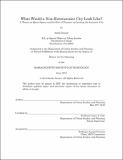| dc.contributor.advisor | Larry J. Vale. | en_US |
| dc.contributor.author | Nusser, Sarah (Sarah Parker) | en_US |
| dc.contributor.other | Massachusetts Institute of Technology. Dept. of Urban Studies and Planning. | en_US |
| dc.date.accessioned | 2010-10-29T13:56:23Z | |
| dc.date.available | 2010-10-29T13:56:23Z | |
| dc.date.copyright | 2010 | en_US |
| dc.date.issued | 2010 | en_US |
| dc.identifier.uri | http://hdl.handle.net/1721.1/59581 | |
| dc.description | Thesis (M.C.P.)--Massachusetts Institute of Technology, Dept. of Urban Studies and Planning, 2010. | en_US |
| dc.description | This electronic version was submitted by the student author. The certified thesis is available in the Institute Archives and Special Collections. | en_US |
| dc.description | Cataloged from student submitted PDF version of thesis. | en_US |
| dc.description | Includes bibliographical references (p. 137-139). | en_US |
| dc.description.abstract | Planning has always interacted with issues of sexuality, but the failure of the literature to address these practices explicitly has led to the silencing of minority sexualities in planning discourse and the severe marginalization of many queer people in cities. To better understand the experiences of queer people (Lesbian, Gay, Bisexual, and Transgender) as a basis for creating new planning frameworks that address the realities and diversity of queer lives, this thesis explores how queer people experience everyday space in the city, particularly the places they feel the most and least comfortable being queer. This thesis asks: how do relationships between the design, management, and spatial characteristics of spaces communicate values about sexual orientation and gender identity? How could planners and designers create more inclusive spaces? To accomplish this, in-depth interviews were conducted with queer participants in Kansas City, MO and Cambridge, MA, the progressive cities in their respective regions. I utilize readings on design, politics, and identity to create a Lynchian framework for evaluating spaces based on fit, control, and access. Lastly, I document the performative characteristics of each space identified in interviews with respect to this framework. I draw conclusions from my research findings and discuss the implications for designers and planners and areas for future research. In particular I discuss the process that planners should go through to begin re-constructing the public realm as inclusive of queer sexualities. Finally, I speculate on the kinds of spaces that might exist in a non-heterosexist city. | en_US |
| dc.description.statementofresponsibility | by Sarah Nusser. | en_US |
| dc.format.extent | 139 p. | en_US |
| dc.language.iso | eng | en_US |
| dc.publisher | Massachusetts Institute of Technology | en_US |
| dc.rights | M.I.T. theses are protected by
copyright. They may be viewed from this source for any purpose, but
reproduction or distribution in any format is prohibited without written
permission. See provided URL for inquiries about permission. | en_US |
| dc.rights.uri | http://dspace.mit.edu/handle/1721.1/7582 | en_US |
| dc.subject | Urban Studies and Planning. | en_US |
| dc.title | What would a non-heterosexist city look like? : a theory on queer spaces and the role of planners in creating the inclusive city | en_US |
| dc.title.alternative | Theory on queer spaces and the role of planners in creating the inclusive city | en_US |
| dc.title.alternative | Theory of queer spaces and the role of planners in creating the inclusive city | en_US |
| dc.type | Thesis | en_US |
| dc.description.degree | M.C.P. | en_US |
| dc.contributor.department | Massachusetts Institute of Technology. Department of Urban Studies and Planning | |
| dc.identifier.oclc | 670598433 | en_US |
